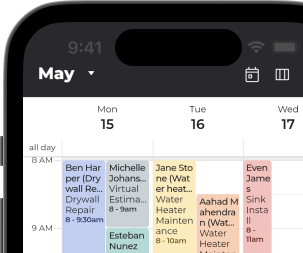Communication plays a vital role in the success of your business. Whether you’re navigating a small startup or growing an established brand, effective communication drives productivity, ensures smooth operations, and fosters strong relationships with employees and customers alike.
Free: Small Business Commmand Center
Get Free Communication Tools Like Phone, Email, and Webchat.
Try Now
But, communication is more than just spoken and written word. There are four forms of communication, and business owners should be well-versed in each one. Understanding and leveraging each form of communication will position you for success and help you lead more effectively.
In this post, we’ll explain the four forms of communication and how you can improve each one as a small business owner.
What are the forms of communication?
The four forms of communication can be described as follows:

1. Verbal Communication
Verbal communication is the most common form of communication. It involves speaking words to convey messages and is the most direct and efficient way to communicate.
In the workplace, people communicate verballing all the time. You’ll talk with customers over the phone or in a video conference, and you’ll speak to coworkers or partners in person.
Verbal communication can also be supported by written and nonverbal communication, like in a speech or a presentation. You would use both verbal and visual communication to present a product or a business plan to stakeholders.
When utilizing verbal communication, keep these goals in mind:
- Influence & Persuasion: Effective verbal communication inspires and motivates others to purchase your products and services.
- Clarity & Understanding: Ask for (or receive) immediate feedback and clarification to reduce the risk of misunderstandings.
- Relationship-Building: Communicating face-to-face, over the phone, and through in-person events builds trust with employees and customers.
For effective verbal communication, always be clear and concise. Keep your message simple and to the point. Be mindful of your tone and the pace of your speech, and encourage dialogue by asking open-ended questions. And, don’t forget to take advantage of your communication tools.
2. Nonverbal Communication
Nonverbal communication refers to body language, gestures, facial expressions, posture, and eye contact. Our physical actions convey messages, and we can use them both intentionally and unintentionally with customers.
Forms of Nonverbal Communication
Here are some common forms of nonverbal communication that affect customer interactions:
- Body Language
- Facial Expressions
- Distancing
- Gestures
At work, nonverbal communication helps employees and customers feel understood, seen, heard, and respected. For example, you would smile when you hear a great idea from a coworker or maintain eye contact when a customer gives you feedback. These details go a long way in improving service interactions and creating positive customer experiences.
Some ways you can improve nonverbal communication are:
- Clarification: Nonverbal cues provide additional context for what we’re saying. You can use them to convey your feelings or clarify what you’re talking about.
- Building Trust: Nonverbal communication boosts trust and credibility. People feel more comfortable working with you if you have positive body language.
- Emotional Connections: Try to avoid being a statue. Facial expressions and body language convey emotions, helping you build lasting connections.
You can also improve your nonverbal communication by maintaining eye contact when someone is speaking to you, paying attention to your facial expressions, and being mindful of posture and personal space.

The Small Business Communications Time Suck is Real
The right communication is vital to your success as a small business. But sometimes it can eat up too much of your time. We’ll show you how to streamline communications in this free guide.
3. Visual Communication
Visual communication conveys information using images, charts, graphs, and infographics. When used properly, it’s a powerful tool for capturing attention and simplifying information. Since customers have different learning styles, visual communication is sometimes the best way for others to retain information.
In the workplace, visual communication is used for PowerPoints, infographics, and charts. It’s also used for posters, signage, and performance reports. These visuals are great for internal communication between employees.
Visual communication is also used for promotional videos, graphics, and social media visuals. TV ads and other videos about your business can catch the eyes of your audience and keep them visually engaged with your message.
Here are a few things to consider when utilizing visual communication:
- Engaging the Audience: Visual elements capture people’s attention and make their experiences more memorable. Be sure to make them interesting and easy to read.
- Reinforcing Your Message: Visuals provide additional context and help you clarify the main points of your message. Use bullet points and brief copy to support your graphics.
- Keeping It Simple: Avoid putting too much information on your visuals — they’ll look cluttered and disorganized.
- Consistent Branding: When you’re creating visuals for your business, make sure every element aligns with your brand’s style, colors, and fonts.
4. Written Communication
Written communication is the act of writing (or typing) to share information. It’s a common communication tool, often shared through books, blog posts, letters, emails, memos, and pamphlets. Written communication is a fantastic way to document information, provide instructions, and maintain records at your business.
You can use written communication to create newsletters, blog posts, and email campaigns for your company. These tools support your marketing campaigns because they’re used on almost every customer engagement software.
Best practices for effective written communication include:
- Reaching a Wide Audience: Written messages are shared quickly and efficiently with a large audience. Email and social media are two channels for sharing information with a wide audience.
- Precision & Permanence: Write a document with answers to frequently asked customer questions (FAQs) or support guides that employees and customers can refer to whenever they have questions about your business.
- Simplicity: Keep things clear and concise whenever possible. You can include a lot of information — just write it clearly and leave out unnecessary details.
- Quality: Set aside time to re-read your emails and memos before sending them. You will identify mistakes and opportunities to improve your writing.
Types of Business Communication
While you can use four forms of communication, each form has two types: formal and informal.
Formal communication includes reports, business meetings, legal notices, and newsletters. These are conversations or environments where you need to look and sound especially professional for your audience.

Informal communication is more casual and allows people to communicate quickly and spontaneously. It often happens on social media, text messages, or in a team chat setting. In these conversations, how you say something might be less important than what you say.
For example, you probably wouldn’t write “lol” in an important business email. However, you might always use that acronym when texting your coworkers. When it comes to communication, your goal is to choose the best format and type for the appropriate time and place.
All Behavior Is a Form of Communication
Effective communication is essential for any business. Pay attention to how you use verbal, nonverbal, written, and visual communication because it will increase employee engagement, improve customer satisfaction, and enhance the productivity of your business.
Start by being clear and concise. Then, think of the connection you’d like to build and choose the right channel to start the conversation. If you’re confident in what you’re communicating, you’ll have everything you need to send a great message.

The Small Business Communications Time Suck is Real
The right communication is vital to your success as a small business. But sometimes it can eat up too much of your time. We’ll show you how to streamline communications in this free guide.


